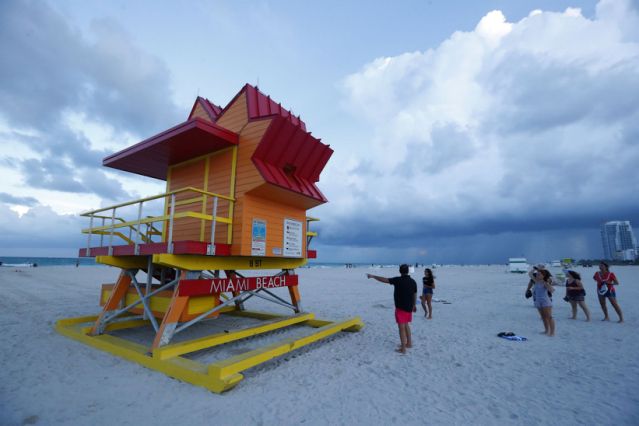
Forecasters expect Dorian, packing 150 mph (240 kph) winds, to hit the northwestern Bahamas on Sunday before curving upward. The storm’s march north could spare the U.S. a direct hit but still threatens Florida, Georgia and the Carolinas with powerful winds and rising ocean water that causes potentially deadly flooding.
In the Bahamas, any remaining tourists were sent to government shelters in schools, churches and other buildings offering protection from the storm.
“My home is all battened up, and I’m preparing right now to leave in a couple of minutes. … We’re not taking no chances,” said Margaret Bassett, 55, a ferry boat driver for the Deep Water Cay resort who chose to leave her home. “They said evacuate, you have to evacuate. It’s for the best interests of the people.”
Over two or three days, the hurricane could dump as much as 4 feet (1 meter) of rain, unleash devastating winds and whip up an abnormal and dangerous rise in sea level called storm surge, according to private meteorologist Ryan Maue and some of the most reliable computer models.
communities and McLean’s Town, a settlement of a few dozen homes on the eastern end of Grand Bahama, about 150 miles (240 kilometers) from Florida’s Atlantic coast.
Most were coming from Sweeting Cay, a fishing town of a few hundred people that’s about 5 feet (1.5 meters) above sea level and was expected to be left completely underwater.
Still, a few fishermen planned to ride it out, which could put them in extreme danger.
“Hoping for the best, that the storm passes and everybody is safe until we return home,” fisherman Tyrone Mitchell said. “All the ladies and children evacuated, and we have about six or seven men that (will) ride out the storm.”
The storm-prone Bahamas on average faces a direct hit from a hurricane every four years, officials say.
Construction codes require homes to have metal reinforcements for roof beams to withstand winds into the upper limits of a Category 4 hurricane, and compliance is generally tight for residents who can afford it. Poorer communities typically have wooden homes and are generally lower-lying, placing them at tremendous risk.
After walloping the islands, forecasters said the ever-strengthening Dorian was expected to dance up the Southeast coastline, staying just off the shores of Florida and Georgia on Tuesday and Wednesday before skirting South Carolina and North Carolina on Thursday.
South Carolina Gov. Henry McMaster declared a state of emergency Saturday, mobilizing state resources to prepare for the possibility the storm could still make landfall. Trump already declared a state of emergency in Florida and authorized the Federal Emergency Management Agency to coordinate disaster-relief efforts.
The National Hurricane Center in Miami said the risk of strong winds and rising water will increase along the shores of Georgia and the Carolinas by midweek.
The center also stressed that Dorian could still hit Florida, where millions of people have been in the storm’s changing potential path. But after days of a forecast that put the state in the center of expected landfalls, the hurricane’s turn northeast is significant.
Carmen Segura, 32, said she had installed hurricane shutters at her house in Miami, bought extra gas and secured water and food for at least three days. She feels well prepared and less worried given the latest forecasts but still a bit uneasy given how unpredictable the storm’s expected track has been.
“Part of me still feels like: So, now what?” Segura said.
Florida Gov. Ron DeSantis warned people not to let their guard down.
“Looking at these forecasts, a bump in one direction or the other could have really significant ramifications in terms of impact,” DeSantis said. “If it bumps further east, that obviously is positive. If it bumps just a little west, then you’re looking at really, really significant impacts.”
Maue, the meteorologist, said that though “the worst effects of a direct landfall are not in the forecast,” ”it’s going to be pretty scary because you’re going to have this gigantic hurricane sitting off the coast of Florida, and it’s not going to move.”
The storm upended some Labor Day weekend plans: Major airlines allowed travelers to change their reservations without fees, big cruise lines began rerouting their ships and Cumberland Island National Seashore off Georgia’s coast closed to visitors.
Disney World and Orlando’s other resorts could be at risk, but they held off announcing any closings, with Dorian days away and its track uncertain.
Sherry Atkinson, who manages a hotel on North Carolina’s Outer Banks, said the hurricane wasn’t spoiling holiday vacations for guests.
“Everybody is just kind of chilly willy. They know it’s not going to bother their weekend,” she said.
Atkinson said she has lived on the Outer Banks for 26 years and that “so far, there hasn’t even been a snippet of conversation about evacuations.”
Florida authorities have not ordered mass evacuations but some counties told residents of barrier islands, mobile homes and low-lying areas to flee beginning Sunday — though those orders could change.
Dorian was centered 385 miles (625 kilometers) east of West Palm Beach and was moving west at 8 mph (13 kph).
In the Bahamas, canned food and bottled water disappeared quickly from shelves and people boarded up their homes.
“We ask for God’s guidance and for God to assist us through this,” Minnis said.





